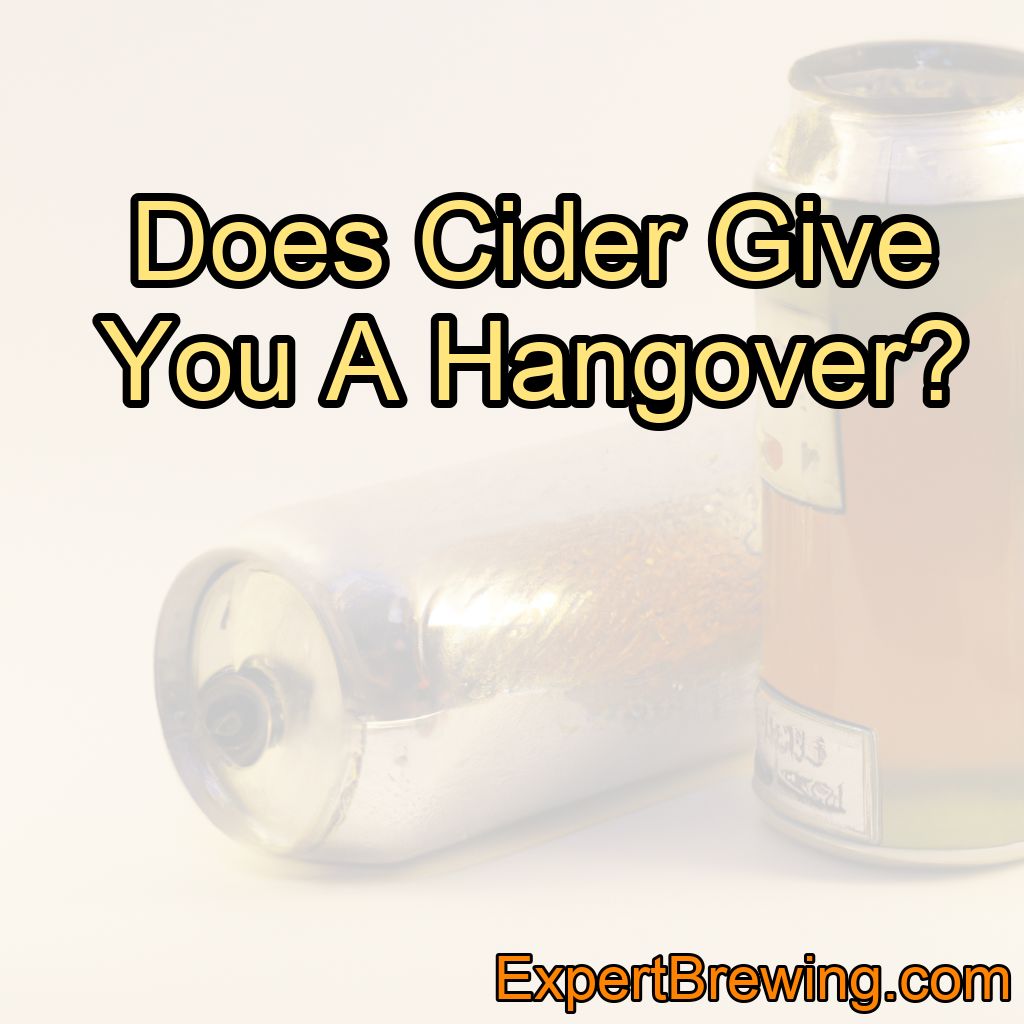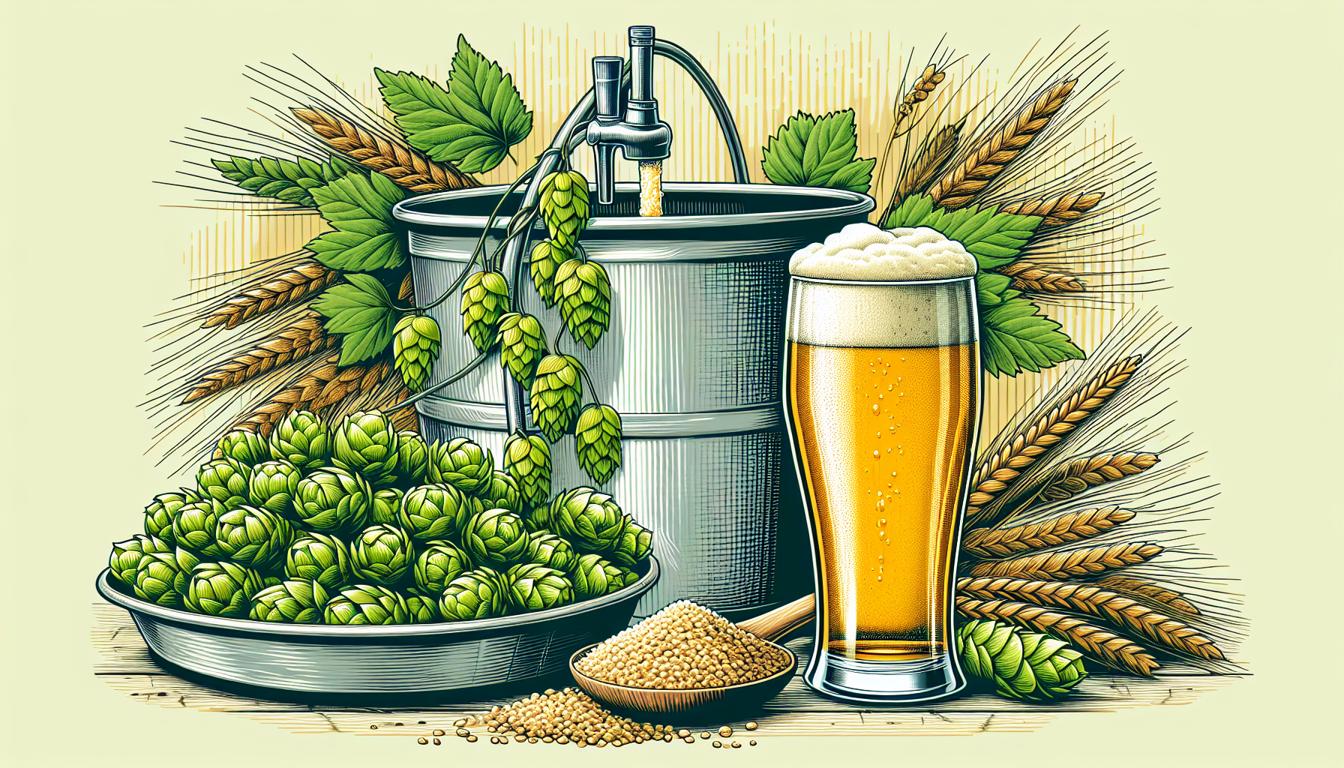As a home brewer, you may be wondering how much priming sugar you need to carbonate 1 gallons (3.8 liters) of your sparkling wine.
So, how much priming sugar per gallon do you need exactly?
For 1 gallons or 3.8 liters of brew, you will want to add 16 grams of sugar to get a well-carbonated drink.
If you prefer a weaker carbonation you will need to add 8 grams of priming sugar per 1 gallons (3.8 liters) to achieve mild carbonation.
However, do not add more than 30 grams for 1 gallons (3.8 liters) as this may lead to over carbonation.
Measured in standard (4 gram) sugar cubes or priming sugar drops, this corresponds to 2, 4, and 8 sugar cubes, for low, medium and high carbonation, respectively.
Maybe this info is all you need, but if you want to know more about natural carbonation, which sugars to use, how to do it and a lot of useful tips – read on!
Understanding The Carbonation Process
Carbonation, or secondary fermentation, is an important factor in creating a great tasting hard cider, beer or wine.

The process of carbonating your beer, cider or wine requires careful attention to temperature and time.
Temperature Requirements:
In order for the yeast to produce carbon dioxide, it needs to be at the right temperature range. This range can vary depending on the type of yeast used, but generally falls between 60-75°F (15-24°C).
For the amounts of sugar suggested here, I have done the calculations assuming a temperature of 65°F (18°C).
It’s best to keep your vessel in a cool area away from direct sunlight or heat sources that could cause fluctuations in temperature.
Higher temperatures will require more priming sugar as the carbon dioxide will have a harder time dissolving in the brew, and lower temperatures will need less priming sugar to get the right carbonation.
Time Frame for Carbonation:
Once you have achieved the desired fermentation temperatures, it’s time to wait for the carbonation process to take place.
The carbonation will, depending on the yeast strain used, happen faster at higher temperatures as yeast ferments optimally at around 86°F (30°C).
Depending on how much sugar was added during priming and what type of yeast was used, this can take anywhere from two weeks up to several months before you reach optimal levels of carbonation.
Most brewer will let the cider age much longer than that though, to ripen the taste profile.
Testing for Carbonation Levels:
Just as you will want to test your hard beer, cider or wine periodically throughout the brewing process, using a hydrometer or other device specifically designed for measuring sugar concentrations, there are devices that allow you to measure pressure in bottles during secondary fermentation.
If you don’t have access to one of these devices, there are also DIY methods such as using (a few) swing-top bottles and opening one every few days – if foam spills out then you know that there is enough CO2 present!
The good thing about swing-top bottles is that you don’t loose all the carbonation as you can quickly close it again and let the carbonation continue – although at reduced effect.
Once all of these steps have been completed and your beer, cider or sparkling wine has reached its desired level of carbonation and is in theory ready for drinking!
Now that you understand the basics of carbonation, let’s move on to discussing the types of priming sugar in more detail.
It Depends On The Type of Priming Sugar
The most common type is table sugar, also known as sucrose. This type of sugar is easy to find in any grocery store and will give your beer a nice balance of sweetness and carbonation.
Dextrose, which is a form of glucose, can also be used for priming. It has less flavor than sucrose but still provides the necessary carbonation levels for your brew.
For 1 gallons, the 16 grams of sugar or 4 ordinary sugar cubes corresponds to dextrose, glucose or sucrose that can easily be digested by most brewing yeasts.
If using syrup or honey, you may want to aim for the higher 30 grams per 1 gallons, as they contain more water and the effective sugar concentration will be lower.
To begin with, we recommend using ordinary table sugar, corn sugar, or glucose.
This is because ordinary sugar is less likely to add any off-flavors to your beer and is easily dissolved.
Other types of sugar that can be used for priming include:
Brown sugar: Brown sugar can add a slight molasses flavor to your beer or cider. You will need 18.0 grams of brown sugar per 1 gallons for good carbonation.
Honey: Honey can add a subtle sweetness and unique flavor to your cider or beer. If you choose to use honey for priming of 1 gallons, you will need 21.4 grams to get the same carbonation as with 16 grams of ordinary sucrose.
Honey should always be added after fermentation has completed in order to preserve its delicate aromas and flavors throughout the brewing process.
Maple syrup: Maple syrup will add a unique sweetness and flavor. For a medium carbonation level, you will need to add 20.6 grams of maple syrup to 1 gallons of brew to achieve good carbonation.
Fruit juice: Fruit juice can add a unique sweetness and flavor to your beer. For juice you will want to use at least 2 times 30 ml per 1 gallon of brew.
More on the sweets
Corn syrup is another option when it comes to priming beers. Corn syrup contains more fructose than other sugars so it will provide more sweetness without adding too much complexity or flavor profile to the finished product.
For corn syrup, you will need 23.2 grams for 1 gallon of brew.
Fructose can also be used for priming but should generally only be added in small amounts since too much could result in overly sweet or syrupy tasting beers or ciders with low carbonation levels as beer yeasts have a hard time fermenting fructose, but for ciders it is generally ok.
Malt extract is often overlooked when considering what type of sugars should go into beer making but this ingredient actually plays an important role in providing additional body while contributing subtle notes of caramelized maltiness at the same time!
For dried malt extract, also known as DME, you will need to add 23.5 grams per 1 gallons in your brew.
Apple juice concentrate can also work well as a natural source of fermentable sugars while powdered sugar adds just enough sweetness without overpowering other ingredients present in the recipe itself!
| Sugar Source | Grams Needed For 1 Gal or 3.8 L |
| Sucrose | 16 |
| Dextrose | 17.5 |
| Brown Sugar | 18.0 |
| Corn Sugar | 17.5 |
| Corn Syrup | 23.2 |
| Molases | 22.3 |
| Maple Syrup | 20.6 |
| Honey | 21.4 |
| Dried Malt Extract | 23.5 |
| Ivert Syrup | 17.5 |
needed for 1 gallons or 3.8 liters of brew.
No matter which type you choose for bottling or priming your homebrews, make sure to measure out each ingredient accurately before adding them into the mix.
This will ensure consistent results every time!
It Also Depends On The Brew Type
Different cider, beer and sparkling wine styles require different amounts of carbonation.
For example, porters, stouts and ales are typically carbonated to around 2 volumes of CO2 and here you should add 16 grams of sugar for 3.8 liters, while witbiers and Belgian stronger beers need a higher carbonation of around 3 volumes corresponding to 30 grams of sugar per 3.8 liters.
The same is the case for ciders and champagne-like fruit wines and some wheat based sour beers.
So if you are brewing a fruity, light wheat type of beer or a sour beer use 30 grams of sugar per 3.8 liters.
If you are brewing a lager or pilsner style beer you will want to stick to the 16 grams of priming sugar per 1 gallons (3.8 liters) to get a roughly 2 times carbonation factor.

One of the key differences between lagers and ales, stouts included, is the carbonation level! And ales are generally less carbonated than lagers.
So for the darker ales, porter and stout types of beers, you should not go much higher than 8 grams of priming sugar per 1 gallons (3.8 liters).
This is because the different styles of beer impact the way the carbonation is perceived. For instance, porters and stouts are typically darker beers, which can make the carbonation seem more aggressive.
IPAs, on the other hand, are often quite hoppy, and the carbonation can help to balance out the bitterness. Witbiers and Belgian stronger beers are usually quite light in color, so the higher carbonation helps to add some perceived body and sweetness.
Ciders
also has varying degrees of fizziness depending on its style and method used for fermentation and bottling/kegging processes.
Traditional ciders are often lightly-carbonated with an effervescence similar to champagne whereas modern ciders may be more highly-carbonated like some beers such as IPAs or lagers due to added sugars during fermentation or through force-carbonating techniques post-fermentation (e.g., kegging).

But it really depends on the region and many traditional Spanish ciders are without carbonation at all – also known as still ciders!
The amount of remaining nutrients, including sugar, also affects carbonation levels as a yeast will not produces as much carbonation in for example a keeved, nutrient deprived, cider compared to one where yeast nutrients have been added.
Sparkling wines
come in many forms including Champagne, Prosecco and Cava which all differ greatly when it comes to their level of bubbles; Champagne is generally very highly-carbonated (often more than 20 grams of sugar added per liter!).
Prosecco tends towards medium levels and Cava is usually lightly sparkling, but can sometimes contain higher amounts if desired by the winemaker/producer.

In summary, each type of alcoholic beverage requires a specific amount of carbon dioxide for an optimal flavor profile.
Too much will result in an overly fizzy drink that is unpleasant tasting, while too little will leave you with something flat and unsatisfying.
When brewing at home it is important to understand what kind and how much CO2 your particular brew needs so that you can achieve the perfect balance between flavor and effervescence every time.
I’ll go into the math later in this post, but if you don’t care about the math and want to just use a priming sugar calculator directly, check out my super easy priming calculator here! to figure out exactly the amount of priming sugar for your style of brew!
How to Make a Priming Solution for 3.8 Liters of Brew
As a homebrewer, there are a few things you need to know in order to bottle your brew and achieve natural carbonation.
One thing that makes priming easier, is to make a priming solution as this makes the distribution of sugar in your final container easier to control.
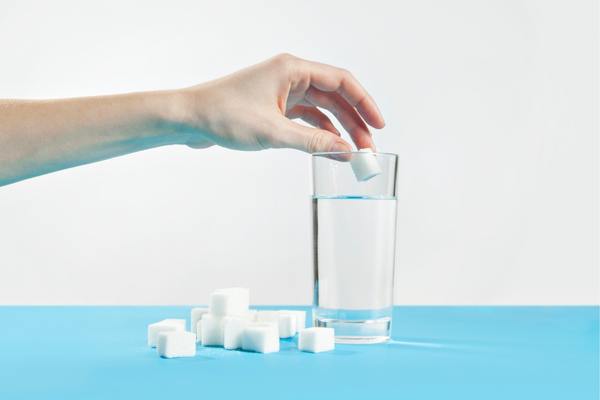
This is simply a matter of mixing the priming sugar with water and, depending on the amount needed, boiling it for a few minutes.
Making this dissolved sugar solution makes it much easier to distribute the sugar equally in your brewing vessel before bottling your brew.
The process of making a priming solution is simple and only requires a few minutes of your time. Here’s how to do it:
- We have calculated that you need 16 grams of sugar per 3.8 liter of brew for good carbonation.
- For this amount I recommend using 16 ml of water and mix it with the 16 grams of sugar.
- Add it to the microwave or (if the volume is too high for that), place the mixture in a pot and bring it to a boil. Allow the mixture to boil for a few minutes.
- Once the priming solution has finished boiling, allow it to cool before using it to bottle or keg.
- If your are bottleling your brew, simply fill each bottle with the priming solution and then add the beer.
- Cap the bottles and store them in a cool, dark place. This amount (16 grams of sugar per 3.8 liter) is calculated to work best at around 60 to 70F (15-20 C).
- After a few weeks, your beer will be carbonated and ready to drink! Enjoy!
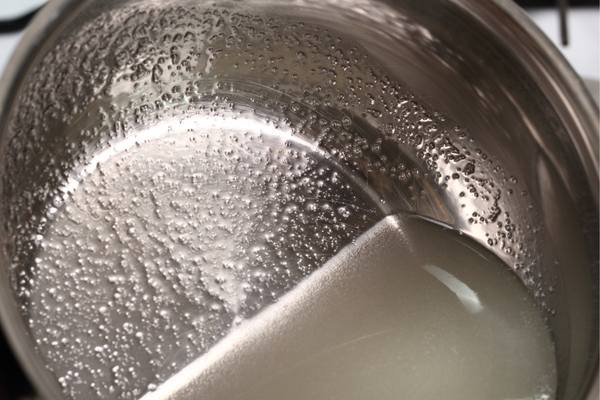
Now, let’s look at the pros and cons of adding the priming sugar to the fermentation batch or to each of the bottles when bottling.
Do You Add Your Priming Sugar Before or After You Fill Your Bottles?
The answer to this question is that it depends on your preference, and whether you want to experiment with different levels of priming sugar in different bottles.
If it is your first time brewing a specific recipe, it might make sense to try different levels out and therefore adding the sugars to the bottles directly, but otherwise I would recommend adding it the the whole batch (batch priming) before bottling.
Most brewers like to add the priming sugar before they fill their bottles so that they can be sure that all of the sugar is dissolved and because they save time this way.
Others like to add the priming sugar after they have filled their bottles so that they can avoid any spillage and try out different sugars or carbonations.
Another advantage is, that you are more certain of the amount of sugar you have in each bottle, as adding the sugar directly to the batch may lead to an unequal distribution of not dissolved and mixed properly.
If you are adding the priming sugar before you fill your bottles, it is best to make a priming solution as I have described above.
Just dissolve the sugar in a small amount of water before adding it so that it will distribute itself more easily in the batch.
For 1, use at least 16 ml or water for 16 grams of sugar to dissolve it properly.
If you are adding the priming sugar after you have filled your bottles, you can simply pour the sugar into the bottles, as there will be not problems with equal distribution within each bottle.

No matter which method you choose, be sure to add the priming sugar to your bottles before you seal them.
This will ensure that the carbonation process can begin and that your cider will be nice and bubbly when you open it.
Tips on How to Bottle and Prime Your Brew Correctly
As a home brewer, it’s important to know how to bottle and prime your brew correctly in order to ensure a great final product.
Here are some tips on how to do just that:
- Sanitize all of your equipment beforehand using a no-rinse sanitizer, boiling water or ethanol.
This will prevent any bacteria from contaminating your beer or cider (and turn it into vinegar!).
- Use the correct amount of bottling sugar for the batch size you are making.
- Again, I recommend using 16 grams of ordinary sugar for a volume of 3.8 liters or 1 gallons.
Too much or too little sugar will affect the taste and mouthfeel of your final product. And worst case, the bottles will not last long…
- Boil the water used to dissolve the priming sugar before adding it to the rest of your ingredients.
- Do not add less than 8 grams per 1 gallons, or you risk not getting any carbonation.
- Also be careful when adding more than 30 to a 1 gallon (or 3.8 liters) container as it can lead over foaming when opening.
- If you add your priming sugar directly to the fermentation vessel before bottling, make sure that the priming solution is distributed well so that each bottle will have the same sugar concentration.
- This can be done by gently stirring the fermenter after adding the priming solution, but most often there will be a layer of yeast that you want to avoid stirring up!
- Therefore, the best way is simply to pour in the priming solution while making sure to distribute it out over the surface of the brew.
You can stir a little bit, and wait 15-30 min. before bottling to allow the yeast to settle back down.
When mixing in your priming solution and when transferring your brew from the fermenter to the bottles or the keg, be careful not to splash it around too much.
Splashing can introduce oxygen into solution which can lead to off flavors in your final product.
By following these simple tips, you’ll be sure to bottle and prime your beer correctly every time!
Troubleshooting Common Issues
When bottling and priming hard cider, beer or sparkling wine there are a few common issues that can arise. Over-carbonated or under-carbonated ciders can be an issue for home brewers. Here are some tips on troubleshooting these problems.
Over-Carbonation
If your cider, beer or wine is over-carbonated, it will have a strong carbonation level with large bubbles and an overly foamy head when poured into the glass.
This is usually caused by adding too much priming sugar during the bottling process or leaving the bottles in too warm temperatures after they’ve been bottled.

To fix this problem, you should chill down your bottles to lower temperatures as quickly as possible and then open them up to release some of the pressure before resealing them again.
You may also want to consider reducing the amount of priming sugar used in future batches if this continues to happen often.
For 1 gallons or 3.8 liters of brew, you will want to add 16 grams of sugar to get a well-carbonated drink.
Under-Carbonation
If your brew is under-carbonated, it will lack any fizziness when poured into a glass and have little to no foam head. This could be due to not enough priming sugar being added during bottling or not allowing enough time for proper carbonation before drinking it (at least 2 weeks).
To remedy this, you can increase the amount of priming sugar used in future batches or give more time for carbonation before consuming it next time around.
Additionally, you can add additional CO2 directly into each bottle using a carbonation system or even a SodaStream setup, which will help increase carbonation levels instantly without having to wait longer periods of time for natural fermentation processes take place within each bottle itself.
Having the right amount of priming sugar is key to achieving the desired level of carbonation in your hard cider, beer or sparkling wine.
For 1 gallons or 3.8 liters of brew, you might want to try 30 grams of sugar next time you prime your brew!
You will also want to check that your priming bottles, kegs or other containers, are completely tight as a small leak will quickly release the CO2 produces instead of dissolving it in the liquid as carbonic acid.
Calculating Priming Sugar Correctly:
The amount of priming sugar needed depends on several factors such as temperature, style of beer and desired level of carbonation.
If you don’t care about the math and want to just use the priming calculator directly, check out my super easy priming calculator here!
As we will see, the main variables are the carbonation pressure, the temperature and the volume.
The formula we have used here is:
Priming Sugar (Grams) = 15.195 × Volbrew × (VolCO2 – 3.0378 + (0.050062 × T(F)) – (0.00026555 × (T(F))2))
Where VolBrew is the volume in gallons of your brew, and VolCO2 is the desired volume of CO2 in your final bottle/keg. T(F) is the temperature in Fahrenheit.
As we have already been through, in the case of sucrose or glucose and a carbonation pressure of 2X this will be:
Grams Priming Sugar = 15.195 × 1 Gal × (2 – 3.0378 + (0.050062 × 65) – (0.00026555 × (65)2)) = 16 grams/1 gal
So, for 1 gallons or 3.8 liters of brew, this results in 16 grams of sugar to get a well-carbonated drink.
For the lower carbonation, a CO2 pressure of 1.5 was used:
15.195 × 1 Gal × (1.5 – 3.0378 + (0.050062 × 65) – (0.00026555 × (65)2)) = 8 grams
So if you prefer a weaker carbonation you will need to add 8 grams of priming sugar per 1 gallons (3.8 liters) to achieve mild carbonation.
And for the high-carbonation option, we have used a 3 times CO2 pressure:
15.195 × 1 Gal × (3 – 3.0378 + (0.050062 × 65) – (0.00026555 × (65)2 = 30 grams
So 30 grams for 1 gallons (3.8 liters) as this may lead to over carbonation.
However, keep in mind that this depends on factors suchs as temperature and the sugars used!
Types Of Sugars Used:
As mentioned earlier, be sure to use the amount corresponding to the sugar type your are using.
Different types of sugars can be used for bottling and priming; these include corn syrup, cane sugar, honey and malt extract.
Each one has its own characteristics so make sure that you’re using the correct type and amount for your particular brew!
Syrups, malts, and honey (complex sugars) needs more sugar than ordinary dextrose or glucose (simple sugars).
This is because they contain water or are harder to digest for the yeast.
Bottling & Priming Processes
The exact bottling or kegging process can also lead to variations in the final carbonation levels.
When bottling and priming your brew there are certain steps which must be followed in order to ensure success.
These include sanitizing bottles/kegs prior to filling them with wort/beer/cider, adding a measured amount of priming solution correctly into each bottle/keg prior to capping/sealing them shut and allowing enough time (usually two weeks depending on storage) for conditioning after bottling/priming before consuming the finished product.
But this depends on when you bottle your cider in the cider making process.
Kegging:
If kegging instead of bottling is performed, then you might not want to add sugars at all. No sugar will need to be added as long as there is already sufficient CO2 is added in the force carbonation process – however it may still be necessary to adjust pressure settings depending on what kind of beverage is being made (e.g., lagers require higher pressures than stouts and other ales).
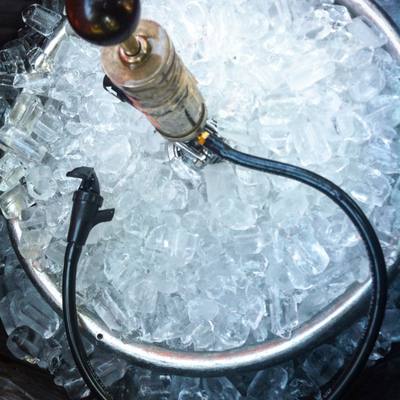
Read more about kegging in our kegging guide here.
By troubleshooting any common problems with bottling and priming, you can ensure that your brew is the best it can be.
Main Takeaways: When bottling and priming hard cider, it is important to pay attention to the amount of priming sugar used as well as the temperature of your bottles.
Too much sugar or warm temperatures can lead to over-carbonation while not enough sugar or not allowing enough time for carbonation can cause under-carbonated ciders.
To prevent these issues, adjust the amount of priming sugar accordingly and chill down bottles quickly if needed.
Additionally, you can add additional CO2 directly if using a keg, which is much easier to control than a secondary fermentation process!
Safety Considerations When Brewing and Carbonating
When carbonating your brew, safety should be a top priority. It is important to follow sanitation practices and use the appropriate equipment and ingredients in order to ensure that your brew is safe to store and consume.
First off, never add too much priming sugar to your brew as this can obviously result in exploding bottles etc. which is quite dangerous.
So, again, I would recommend a maximum 30 grams for 1 gallons (3.8 liters) as this may lead to over carbonation.
This will result in a maximum of 3x carbon dioxide pressure, which most standard bottles should be able to withstand.
Sanitation Practices to Follow During Brewing Processes:
Sanitizing all of your equipment prior to use is essential when it comes to making sure that you don’t introduce any unwanted bacteria into your brew.
All surfaces, tools, and containers should be cleaned with an approved sanitizer before being used in the brewing process. Additionally, all ingredients should also be properly sanitized before they are added into the mix as well.
It is essential to adhere to proper sanitation practices during the brewing process, as well as only using high-quality equipment and ingredients when making hard cider, beer or wine.
This will help prevent spoilage that will add off-tastes or bad smells to your final product. Make sure all supplies are stored correctly in order for them to remain fresh until ready for use in the fermentation process.
Brewing can be a safe and enjoyable process when the proper safety considerations are taken into account. Now let’s look at the sanitation practices to follow during brewing processes.
If you are unsure how your cider should taste, or want some tips on how to make it taste better or appear clearer and more visually appealing, be sure to check out my other articles on this blog!
Conclusion
Overall, adding 16 grams of priming sugar to 1 gallons of your beer or cider is a good idea if you want to achieve the perfect amount of natural carbonation.
Just be sure to use the correct amount of sugar and dissolve it completely before adding it to your bottles.
And I would not recommend adding more than 30 grams, as this may over-carbonate your brew and lead to spilling or even rupture of the container you end up doing your secondary fermentation in!
Also remember, that hard cider does not necessarily need to be carbonated, and still ciders can also be a great option for some!
With a little experimentation, you’ll be sure to get the perfect carbonation for your homemade beverages every time!




